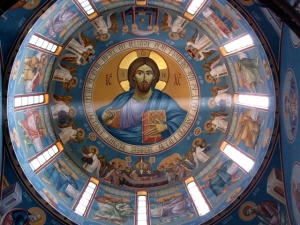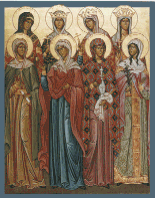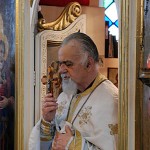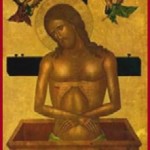Chapters 7 and 8 of Behr-Sigel’s essays centre on the central theme of Mme. Sigel’s life, the issue of women and men in the Church. As these chapters are read, it must be pointed out that the essays were written for the most part in the 1980’s and 1990’s. The reason I call this to the mind of readers is that at that time this topic was being encouraged by the general trends in ecumenical and theological scenes world-wide. Unfortunately, the extension of this movement, a more significant role for women in the Church, led to a relativism that opened the door for the current and more difficult issue within the contemporary ecumenical setting. The newest difficulty for the Orthodox is the problem of the role of practicing homosexuals, be it their “marriage” or ordination.
The injustice is that this current development has pushed aside the valid concern of the role of women. This issue is a topic that must be faced with thoughtful study and consideration. Behr-Sigel introduces her approach to this topic with a discussion of the question of Holy Tradition vs. common tradition. This inquiry is tantamount to the consideration of the conversation about women and the Church. What is true Tradition and what is custom? Our Church is a Church of Living Tradition; from this Holy Deposit of truth springs all the teachings of the Church. The Bible, the dogmas, the teachings of the Holy Fathers and Mothers of our life as a people of God are all part of Holy Tradition. This Tradition is the sinew of faith. In addition, the life of the Church in history develops traditions with a little “t” which are the practices and customs which acculturate the Church in a time and place. There are times that these two traditions are confused. They are not only confused, but in an attempt to preserve essential Tradition, everything is zealously preserved even the non-essential. What is the true authority by which the Church is regulated? Within these two traditions, the ferment and question of the role of women becomes entangled. Did we not have women deaconesses within the Holy Tradition of our Church? Did we not see their diminished manifestation in the tradition (little t)? The Church of today must grapple with this question. Behr-Sigel asks the difficult questions, while witnessing to the process by which the Church is using to deal with these matters.The theological foundation which forms the backdrop of this conversation is the subject matter of the next few chapters.The beginning point is, of course, the example of Jesus and His relationship with women. The essay points out correctly Our Lord dealt with the person, not with groups. He encountered individual humans, not men or women, not colours or nationalities, nothing but a personal encounter with God was the reality of coming face to face with the Messiah. Behr-Sigel rightly calls to our attention that Jesus shattered the “tradition” of His time concerning with whom he “should” associate. Women, tax collectors, adulterers, prostitutes, Samaritans, lepers, those possessed by demons; none were taboo for the touch of the Master. These examples are telling us what is important is the person relationship with Christ, the encounter not the convention of society. Is this example borne out in the life of Church? What is the Tradition and what is tradition?
]]>

 [/caption]
She strongly wished to continue a monasticism open to the world in the manner of Alexander Bukharev. In the 1930s she reached out to the suffering poor of Paris. A controversial socially active monasticism caused a scandal with more conservative church members, but Mother Maria endured. With the advent of World War II, Mother Maria and her friends reached out to help Jews hide and escape Nazi persecution. She was betrayed to the Germans and was put to death, taking the place of a young girl scheduled to die in the gas chambers. Her martyrdom took place in the last days of the war in Ravensbruck concentration camp; On January 18, 2004, the Holy Synod of the Ecumenical Patriarchate in Istanbul recognized Mother Maria Skobtsova as a saint along with her son Yuri, the priest who worked closely with her, Fr. Dimitri Klépinin, and her close friend and collaborator Ilya Fondaminsky. All four died in German concentration camps. On January 18, 2004, the Holy Synod of the Ecumenical Patriarchate in Istanbul recognized Mother Maria Skobtsova as a saint along with her son Yuri, the priest who worked closely with her, Fr. Dimitri Klépinin, and her close friend and collaborator Ilya Fondaminsky.]]>
[/caption]
She strongly wished to continue a monasticism open to the world in the manner of Alexander Bukharev. In the 1930s she reached out to the suffering poor of Paris. A controversial socially active monasticism caused a scandal with more conservative church members, but Mother Maria endured. With the advent of World War II, Mother Maria and her friends reached out to help Jews hide and escape Nazi persecution. She was betrayed to the Germans and was put to death, taking the place of a young girl scheduled to die in the gas chambers. Her martyrdom took place in the last days of the war in Ravensbruck concentration camp; On January 18, 2004, the Holy Synod of the Ecumenical Patriarchate in Istanbul recognized Mother Maria Skobtsova as a saint along with her son Yuri, the priest who worked closely with her, Fr. Dimitri Klépinin, and her close friend and collaborator Ilya Fondaminsky. All four died in German concentration camps. On January 18, 2004, the Holy Synod of the Ecumenical Patriarchate in Istanbul recognized Mother Maria Skobtsova as a saint along with her son Yuri, the priest who worked closely with her, Fr. Dimitri Klépinin, and her close friend and collaborator Ilya Fondaminsky.]]>  [/caption]
The priest blesses and calls for “peace for the congregants and they respond asking for his spirit to be peaceful. Clergy exchange the Kiss of Peace. With the exception of the personal pronouns “we and us,” peace is the single most often used word in our liturgy. After focusing on the centrality of peace in the liturgy, Elisabeth then discusses the effect that nationalism and national identity influence the Church and its mission to strive for peace among nations. No doubt, complex geopolitical issues affect the closely knit church-state relations in many Orthodox countries. Behr-Sigel points out areas of concern to Orthodox peoples; Serbia (note the date of the article), Palestine, and the cooperation of Constantinople, Russia and the WCC and peace efforts. Never the less, the increased presence of Orthodoxy in the west should help provide a catalyst for a pan-orthodox peace movement. For further information link to the Orthodox Peace Fellowship (
[/caption]
The priest blesses and calls for “peace for the congregants and they respond asking for his spirit to be peaceful. Clergy exchange the Kiss of Peace. With the exception of the personal pronouns “we and us,” peace is the single most often used word in our liturgy. After focusing on the centrality of peace in the liturgy, Elisabeth then discusses the effect that nationalism and national identity influence the Church and its mission to strive for peace among nations. No doubt, complex geopolitical issues affect the closely knit church-state relations in many Orthodox countries. Behr-Sigel points out areas of concern to Orthodox peoples; Serbia (note the date of the article), Palestine, and the cooperation of Constantinople, Russia and the WCC and peace efforts. Never the less, the increased presence of Orthodoxy in the west should help provide a catalyst for a pan-orthodox peace movement. For further information link to the Orthodox Peace Fellowship ( [/caption]
The kenosis of Our Lord is at the center of Orthodox theology. God humbling Himself to take on flesh, so that He could identify with us His creation is the essence of His salvific mission in obedience to the will of the Father. The hymns, poetry and art of the Church bear witness to this tenet. Behr-Sigel describes the prevalence of this concept in Russian theological thought and literature. The monastic vocation is a true reflection of this theological concept and has been since its inception in the Egyptian and Palestinian deserts. Modern Greek theologians Zizioulas, Nellas, and Vlachos; in addition to many familiar Russian theologians have written about this aspect of Orthodox theology. Dr. Behr-Sigel masterfully weaves the theme of kenosis and its imprint on the soul of Russia and her people.]]>
[/caption]
The kenosis of Our Lord is at the center of Orthodox theology. God humbling Himself to take on flesh, so that He could identify with us His creation is the essence of His salvific mission in obedience to the will of the Father. The hymns, poetry and art of the Church bear witness to this tenet. Behr-Sigel describes the prevalence of this concept in Russian theological thought and literature. The monastic vocation is a true reflection of this theological concept and has been since its inception in the Egyptian and Palestinian deserts. Modern Greek theologians Zizioulas, Nellas, and Vlachos; in addition to many familiar Russian theologians have written about this aspect of Orthodox theology. Dr. Behr-Sigel masterfully weaves the theme of kenosis and its imprint on the soul of Russia and her people.]]>